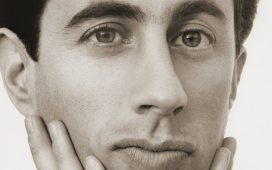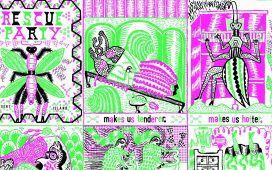It’s such a lovely photograph—if only it were real. The occasion is Mothering Sunday, the U.K. equivalent of Mother’s Day, which fell this year in March. Mom sits at the center, big toothpaste smile, and she’s having a great hair day. She’s pulling her two little ones close to her on either side, and her oldest boy is just behind, beaming affection, his arms slung around her. They all seem to be laughing at whatever the photographer—Dad—is saying or doing. It’s sweater weather, and they look so cozy in their knits (that fluttery scalloped collar under the girl’s cardigan! A dream!). This picture is why people have kids; it’s why people scroll Instagram wondering why everybody else’s family is nicer than theirs. If there was something faintly uncanny about the photo—did Mom’s head seem to float on a different plane? Was her neck somehow foreshortened, or was that just the cowl-neck on her sweater?—maybe it was just the sense of otherworldly perfection.
Because the mom in the picture is Catherine, Princess of Wales, who has been recuperating from abdominal surgery and been out of the public eye since Christmas, and because the credited photographer is William, the future King of England, the image was released to news agencies and posted to the British Royal Family’s social-media accounts, pointedly dated “2024.” Sweet as the picture was, something possibly ghoulish haunted the motivations behind its publication. The moment it hit the Internet, it scanned as a proof of life for a princess who had become indefinitely invisible without much explanation, leaving a void that people filled with rampant speculation and conspiracy theories. The audience for the photograph was large, and they peered at it closely. Perhaps inevitably, they thought they saw strange things: not just touch-ups of hair or skin, but serious tampering.
Amateur analysts should always tread lightly when it comes to digital photos, which are typically full of noise and junk. Once, many years ago, a snapshot of my cat wandered onto the Internet and became a lower-tier meme—“Invisible Motocross”—inspiring passionate discussion across an anonymous Venn diagram of cat-culture scholars and forensic-photography sleuths about how the distribution of light and shadow behind my cat and the way her furry outline cut against the background proved, without a doubt, that the photo was a fake. (My rebuttal: If I knew how to use Photoshop, I would have edited in a nicer living-room backdrop. That apartment was such a shithole!) Stare at any meaningful image for too long and you will eventually end up in the back yard with Lee Harvey Oswald, taking measuring tape to shadows, trying to strike that strange backward-leaning pose, looking like somebody’s patsy.
The Middleton-Windsor photograph, alas, was not an Invisible Motocross situation. What tears it is a spot not far below Kate’s collar—a seeming delineation between what appear to be two discrete images. This digital boundary cuts the zipper on Kate’s jacket in two and blurs the bottom half. It’s like a pattern mismatching at the seam of a poorly stitched garment, and, once you see it, you start seeing all the other torn and puckering seams in the image: the way Princess Charlotte’s wrist looks too big for her sleeve, which seems to be melting into her skirt; the way that strange snippets of hair fall on and blend into various shoulders. Soon, in an extraordinary and humiliating wave of repudiation, news agencies including the Associated Press, Agence France-Presse, Reuters, and Getty all issued kill notices for the picture, forbidding its distribution on their channels. “AT CLOSER INSPECTION IT APPEARS THAT THE SOURCE HAS MANIPULATED THE IMAGE,” the A.P.’s notice explained, going on to say that an unedited version of the photo would not be forthcoming. On TikTok, an impressively resourceful sleuth dug up video from a 2023 charity event, in which Kate and her children seemed to be in the same outfits that they wore in the supposedly new, post-surgery picture.
Damage control begat more reason for damage control. Despite the Royal Family’s famous dictum “Never complain, never explain,” an apology was issued: “Like many amateur photographers, I do occasionally experiment with editing. I wanted to express my apologies for any confusion the family photograph we shared yesterday caused.” The statement was signed “C,” for Catherine, even though William was the credited photographer, and thus ever so slightly more plausible as the Kensington Palace employee who is responsible for doing touch-ups on official photographs.
A furious Daily Mail editor declared that Kate had been “thrown under a bus” by Kensington Palace—forced to take the fall for a major institutional lapse: “I think it’s disgraceful, I think it’s very ungentlemanly of Prince William to put the onus on her. For goodness sake, he’s the one who took the photograph.” On social media, video circulated of an interview with Prince Harry, professional royal defector, talking about the family’s propensity for naming scapegoats in times of P.R. crisis. (As many have pointed out, it may be impossible to exaggerate the media tsunami that would have erupted if Meghan Markle, whom the U.K. press always cast as the Wicked Witch of the West against Kate’s diaphanous, do-no-wrong Glinda, had distributed a doctored photo of herself with Archie and Lilibet.)
At a certain point, the attempted crisis management began to look almost intentionally self-sabotaging. A grainy image emerged of William and Kate in the back seat of a car leaving Windsor Castle; Kate is turned away from the camera, in one-quarter profile. Almost immediately, a savvy royal watcher found a 2016 image of Kate, which appears to map onto the paparazzi snap with suggestive precision. The photographer who claimed credit for the car picture, which was syndicated through an agency called GoffPhotos, denied to the New York Post that any editing shenanigans had taken place. But the discovery of the older picture intensified the ghostliness of the new one, casting Kate, in her demure chignon and pillbox hat, as a gothic apparition that you can’t be sure you really see, like the lady in the lake in “The Turn of the Screw” or the woman in the doorway of the grand house of Tony Soprano’s afterlife. Suddenly there was a chill in the air, a shiver down the spine.
The most plausible explanation for Kate’s absence remains the simplest, and it is also the one that was announced in the first place, back in January: she is recovering from major surgery. What Kensington Palace did not disclose at that time was how hopelessly naïve it appears to be about technology, social media, and its global public’s sophisticated understanding of them both. As David Yelland, a former editor of the U.K. tabloid the Sun, said on a podcast he co-hosts, “I think this is a twentieth-century organization, maybe even a sixteenth-century organization, trying to play twenty-first-century games.” Some of their failings, however, are timeless. “The royal body exists to be looked at,” the novelist Hilary Mantel wrote in a controversial and brilliant 2013 essay for the London Review of Books. If Kate is not seen, she ceases to exist; she seems to die, and throws her public into a confused quasi-mourning that demands deft and elegant intercession. (There was a whole movie about this!) Nobody at any time, neither a subject of Elizabeth I nor a TikTok influencer in 2024, would ever be satisfied by a smudged glimpse of maybe-Kate’s ear and cheekbone—which is all that the GoffPhotos picture had to offer—as evidence of the royal body’s good health.
The rap on Kate was always that, despite her abundant beauty, charm, and high-heeled indefatigability—maybe in part because of it—she was boring, especially in contrast to Diana, her husband’s mother and eternal Princess of Wales, who possessed all of Kate’s gifts and more: vulnerability, unpredictability, a certain irresistible too-muchness. Mantel, in her London Review of Books essay, called Kate, not without empathy, “a shop-window mannequin, with no personality of her own.” Mantel went on, “She appears precision-made, machine-made, so different from Diana whose human awkwardness and emotional incontinence showed in her every gesture. Diana was capable of transforming herself from galumphing schoolgirl to ice queen, from wraith to Amazon. Kate seems capable of going from perfect bride to perfect mother, with no messy deviation.”
The time line of Diana’s fascinating transformations can be tracked in indelible, often appealingly imperfect images: the teen-age day-care worker unaware of the sun shining through her translucent skirt; the demure bride floating on plumes of taffeta; the doting young mother nuzzling her boys in casual photos taken en plein air; the supermodel in the revenge dress; the jet-setting divorcée getting papped on a playboy’s yacht. Kate could never achieve the iconic stature that Diana built from these images, and likely she never wanted to. (It is not terribly reductive to say that Diana died in the midst of doing what Kate is struggling to do now: deal with the press.) But, aside from her wedding to William, in 2011, the ongoing uproar over these recent photographs is the most captivating episode of Kate’s entire public career, and all because of a spectacularly failed attempt to present the perfect image. ♦








